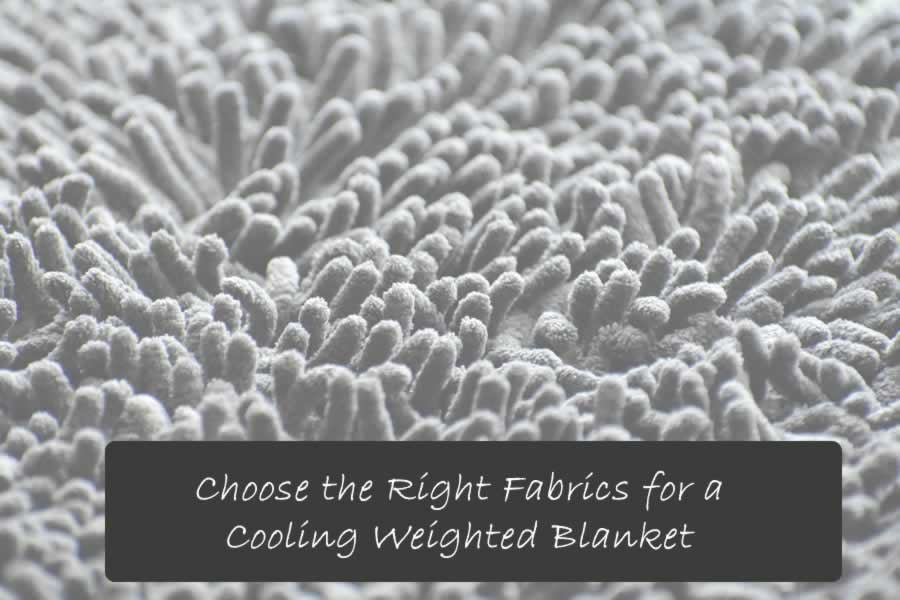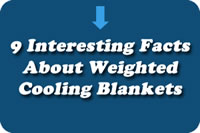How to Choose the Right Fabric for a Cooling Weighted Blanket
By Oktay Ozadam

What are the perfect fabrics for a weighted cooling blanket?
We feel that it is vital when choosing a weighted blanket (for yourself or a loved one), to be aware of the quality of the product you're purchasing. As with anything, a blanket of poor quality will do more harm than good, and it will not provide the desired cooling effect.
Likewise, a quality blanket will be made with your best interest at heart and will use fabrics that are people-friendly. Typically, these fabrics won't trap moisture or cause your body to feel clammy or stifled during sleep.
A lot of people wonder – do weighted blankets make you hot? And the answer is, they don't have to, provided you pick one made of the right fabric.
That Being Said, What Is the Best Fabric For A Weighted Cooling Blanket?
Well, there's quite a bit of debate on the subject, so much that we can't pick any one fabric as the best. We can, however, tell you what fabrics will prove the most breathable and won't make your body feel like it's traversing the Sahara desert.
1. Cotton
Cotton is among the most popular fabrics used in weighted blankets (as well as clothes and other apparel) because of its' breathability. However, not all cotton is created equal. Cheap cotton can make you over-heat and can, in rare cases, even cause health issues.
This leads us to pure, organic cotton, which is, as you might imagine, much more expensive. However, we feel it's worth it, because:
- Organic cotton has high breathability;
- Organic cotton can help regulate your body's temperature during sleep, because of the cooling feeling it provides against your skin;
- It's eco-friendly and hypoallergenic;
- Also very easy to wash.
Two major minuses of cotton, however, are the fact that it tends to shrink (obviously not what we want in a blanket), and it tends to absorb moisture. Not as much moisture as synthetic fabric, for example, but still, it can draw the sweat from your pores and create a clammy feeling – not ideal for sleep.
Still, it's a worthwhile and robust fabric option.
You might also consider opting for satin-cotton, as that doesn't absorb moisture and sweat.
2. Bamboo
Bamboo blankets can be made of 100% organic bamboo or can constitute a mix of cotton, polyester, and bamboo. They're an excellent choice for fabric in a weighted cooling blanket because:
- It's really soft;
- Highly organic;
- Very breathable;
- Works well both in the cold months and in summer;
- Does not absorb moisture.
Indeed, in many ways, bamboo seems like an ideal option for fabric, although it needs to be washed with care, so as not to encourage microbial growth. Another complaint some people have with bamboo is that it does not allow for many printing patterns, and as such, your blanket can look a bit dull.
But well worth it, considering its' many benefits.
3. Microfiber
Microfiber is a fabric that is on the rise lately, due to its' many benefits and generally easy up-keep. It's becoming somewhat a popular choice of fabric for weighted blankets as well, mainly thanks to:
- It's very easy to clean and dries fast;
- It is breathable, but at the same time, warm;
- It's very soft against the skin and feels light on top of you.
However, one aspect we decidedly do not like about it is that its synthetic fiber, and as such, it can irritate the skin, especially if you're someone with sensitive skin.
It also can get quite static-y, which is not something we're looking for in a blanket.
Lastly, it is not durable.
We recommend it as a last option, but we highly encourage you to opt for bamboo and cotton (silk-cotton or Egyptian cotton are both particularly nice on the skin) if possible.
Fabrics to Stay Avoid, If You Want A Cooling Weighted Blanket:
- Flannel: While flannel is great for the cold, winter months, it's simply far too hot for people who are looking for a cooling blanket. It will feel stifling on hot sleepers, so best avoided;
- Fleece: Like flannel, it gets really warm, so great for winter, not so great as a cooling blanket. Also, it tends to absorb sweat and catch a smell, and those two clearly don't work well together;
- Minky: A soft, kid-friendly fabric, minky blankets can be great for cold sleepers, but for many, are just far too warm;
- Polyester: The biggest no-no in our book, polyester, is irritating and practically not at all breathable. It's the worst possible choice for hot sleepers.
- Acrylic: Another one we prefer to avoid, acrylic is made of petrol, can cause allergies, and to top, it all of, is not breathable and can irritate sensitive skin.
Last Words

It's not necessarily easy to choose the right weighted blanket. It can take days of debate, especially if you share the bed with someone, but we urge you to do your research on fabric, as well as some of the other aspects to avoid/look for when picking out a blanket. It can make a world of difference.
That being said, we hope we helped you choose the right fabric for a weighted cooling blanket!